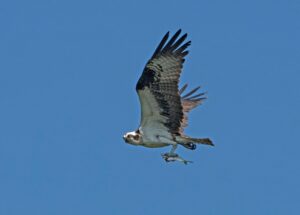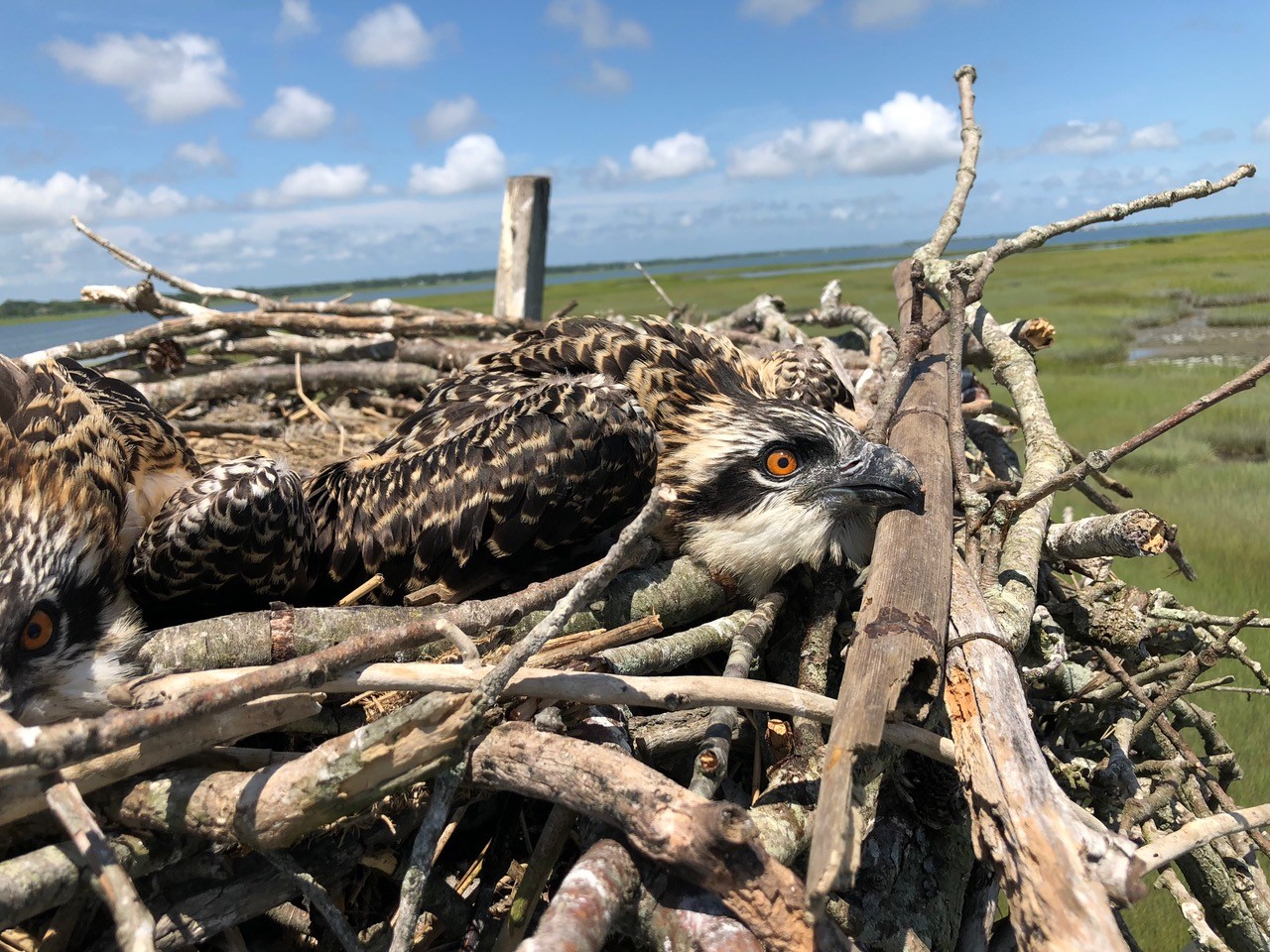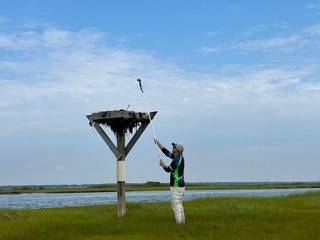Sustainable Margate Chairman Steve Jasiecki holds up an American flag he retrieved from an osprey nest.
By NANETTE LoBIONDO GALLOWAY
MARGATE Sustainable Margate Chairman Steve Jasiecki July 6 provided the Board of Commissioners with information about the green team's goal to obtain Sustainable Jersey recertification in 2024. The highlight of his report was his involvement in a volunteer program to count osprey chicks living in the bays and Great Egg Harbor River Watershed.
It seems we have patriotic ospreys in Margate, Jasiecki said.
He unfolded a piece of fabric he pulled out of his pocket to reveal a small American flag he retrieved from one of the osprey nests.
This is not the first flag I found, he said.
Jasiecki said he volunteers with Bill Stuempfig for the Conserve Wildlife Foundation NJ to inspect osprey nests each year from June 20-July 10, when the fledgling chicks are out of their shell but not big enough to fly away.
 Ospreys are an indicator species, he said. They are a clue to the health of the wetlands. A good population is a clue that the marshes are healthy.
Ospreys are an indicator species, he said. They are a clue to the health of the wetlands. A good population is a clue that the marshes are healthy.
Jasiecki said Stuempfig's team counted 28 new chicks during this year's count.
There are usually three chicks to a pair but often there can be just one or two, Jasiecki said. Sometimes there are no chicks, and the nests are unoccupied. Previous surveys tell us if a nest has or has not been active.
Their parents, which can be quite aggressive when humans peek into their nests, fly away and emit a shrill sound alerting their chicks to play dead with their eyes open, said Fred Akers, who volunteers to count chicks on 45 osprey nests on the Wild and Scenic Great Egg Harbor River and its tributaries located west of the Garden State Parkway.
Sometimes they dive at us, Jasiecki said. We work as quickly as possible to avoid disturbing them too much.
There are manmade osprey nests in coastal areas from Sandy Hook to Cape May, he said.

The state says we can disturb them from June 20 to July 10 because that's when it is least disruptive for the osprey population, he said. That's when their eggs would have hatched, and they are still small enough not to fly off.
Jasiecki said inspections reveal all kinds of marine debris brought back to feather the nest, some of which are dangerous to the raptors, such as fishing rods and line, articles of clothing, and pieces of plastic.
When possible, we remove the debris. Balloons are especially problematic because the ribbons attached to them can strangle the newborns.
Jasiecki said they seem to like thick dog leashes because he found several in one nest.
They must love rope, he said.
 An osprey pair in a nest.
An osprey pair in a nest.
In addition to counting chicks, the volunteers assess the condition of their perches.
We note if the nest needs cleaning, or the platforms need repairs. Sometimes the nests get too heavy for the platforms, Jasiecki said.
The purpose of the annual project is to count osprey chicks to determine the health of the species, which was deemed endangered in 1974 after DDT, banned in 1968, killed off many of them decades ago. Since banning the chemical, the species has rebounded.
Akers said teams of volunteers go out to the nests by boat two hours before high tide and work until two hours after the tide recedes. To minimize disruption, teams use GoPro cameras attached to a stick to film the chicks for the count.
 Jasiecki uses a GoPro camera mounted on a pole to count chicks in an osprey nest.
Jasiecki uses a GoPro camera mounted on a pole to count chicks in an osprey nest.
Last year, the count was down because of all the storms, and they couldn't fish for food, Jasiecki said. We had a good count this year in our coastal area.
All the nests are logged into GPS coordinates, and all have an official state-designated number. The platforms are designed to specific specifications and plans are available on the NJ Fish and Wildlife website, along with the results of the counts, Akers said.
Their natural habitat is mostly gone due to development.
They have recovered and are doing well and for the most part, are dependent on manmade nesting structures because all of the tall trees have been removed from coastal areas due to housing development, Akers said. They only eat fish and need to nest next to the water to feed their young.
 A volunteer erects an osprey platform.
A volunteer erects an osprey platform.
Nesting on power lines is dangerous for them, so the platforms were designed and erected to provide the high perch they prefer. Akers said there were 25-30 platforms erected in the area he covers.
Some residents who live along the water have erected their own nesting platforms and may not be aware of the design criteria, Akers said.
NJ Division of Fish, Game and Wildlife doesn't want any more platforms erected, he said.
We no longer need to put up any more platforms. There's enough now to sustain the population and what we focus on is maintaining what's there, Akers said. We need to keep up with that because the platforms are exposed to the elements, deteriorate and need to be replaced.
He said replacing platforms are prime projects for Boy Scouts seeking their Eagle badges.
Repairs are made in the late fall after the ospreys have left their nests for the season.
It's amazing, the more involved you get with green team activities, you learn these animals are very smart and adaptable, and so very important for our marine environment, Jasiecki said.
And yet, in the Downbeach coastal area, they are dependent on humans for their survival.
Jasiecki cautioned anyone who would try to get near the ospreys.
Ospreys are a protected species. People are expected to keep a safe distance from their nests.
https://youtu.be/rzd8rVJjQNI
Copyright Mediawize, LLC 2023